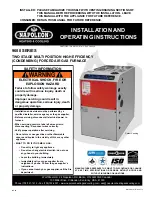
ADJUSTMENTS
1. Set gas input rate
Furnace gas input rate on rating plate is for installations at
altitudes up to 2000 ft. Furnace input rate must be within
±
2
percent of input on furnace rating plate.
a. Determine natural gas orifice size and manifold pressure
for correct input.
(1.) Obtain average yearly gas heat value (at installed
altitude) from local gas supplier.
(2.) Obtain average yearly gas specific gravity from local
gas supplier.
(3.) Verify furnace model. Table 6 can only be used for
model 58PAV Furnaces.
(4.) Find installation altitude in Table 6.
NOTE:
For Canada altitudes of 2000 to 4500 ft, use U.S.A.
altitudes of 2001 to 3000 ft in Table 6.
(5.) Find closest natural gas heat value and specific gravity
in Table 6.
(6.) Follow heat value and specific gravity lines to point of
intersection to find orifice size and manifold pressure
settings for proper operation .
EXAMPLE: (0—2000 ft altitude)
Heating value = 1025 Btu/cu ft
Specific gravity = 0.62
Therefore: Orifice No. 43*
Manifold pressure 3.3-in. wc
* Furnace is shipped with No. 43 orifices. In this example
all main burner orifices are the correct size and do not need
to be changed to obtain proper input rate.
(7.) Check and verify burner orifice size in furnace.
NEVER
ASSUME
ORIFICE
SIZE.
ALWAYS
CHECK AND VERIFY.
b. Adjust manifold pressure to obtain input rate.
(1.) Remove regulator adjustment seal cap. (See Fig. 12.)
(2.) Turn adjusting screw, counterclockwise (out) to de-
crease manifold pressure or clockwise (in) to increase
manifold pressure.
NOTE:
This furnace has been approved for a manifold pressure
of 3.2-in. wc to 3.8-in. wc when installed at altitudes up to 2000 ft.
For altitudes above 2000 ft, the manifold pressure can be adjusted
from 2.0-in. wc to 3.8-in. wc.
DO NOT bottom out gas valve regulator adjusting screw.
This can result in unregulated manifold pressure and result in
excess overfire and heat exchanger failures.
NOTE:
If orifice hole appears damaged or it is suspected to have
been redrilled, check orifice hole with a numbered drill bit of
correct size. Never redrill an orifice. A burr-free and squarely
aligned orifice hole is essential for proper flame characteristics.
(3.) After correct manifold pressure is obtained, replace
gas valve regulator adjustment screw cap and verify
adjusted gas input rate using method outlined in item
c.
(4.) Burner flame should be clear blue, almost transparent.
(See Fig. 13.)
c. Verify natural gas input rate by clocking gas meter.
NOTE:
High-Altitude Adjustment
United States
At installation altitudes above 2000 ft, this furnace has been
approved for a 4 percent derate for each 1000 ft above sea level.
See Table 7 for derate multiplier factor.
EXAMPLE:
88,000 Btuh input furnace installed at 4300 ft.
Furnace Input
Rate at
Sea Level
X
Derate
Multiplier
Factor
=
Furnace Input Rate
at Installation
Altitude
88,000
X
0.82
=
72,160
Canada
At installation altitudes from 2000 to 4500 ft, this furnace must be
derated 10 percent by an authorized Gas Conversion Station. To
determine correct input rate for altitude, see example above and
use 0.90 as derate multiplier factor.
a. Turn off all other gas appliances and pilots.
b. Start furnace and let operate for 3 minutes.
c. Measure time (in sec) for gas meter test dial to complete 1
revolution.
d. Refer to Table 8 for cu ft of gas per hr.
e. Multiply gas rate (cu ft/hr) X heating value (Btu/cu ft)
using
natural
gas
heating
value
from
local
gas
utility/supplier.
EXAMPLE: (0—2000 ft altitude)
Btuh input from rating plate = 110,000 Btuh
Btu heating input = Btu/cu ft X cu ft/hr
Heating value of gas = 1050 Btu/cu ft
Time for 1 revolution of 2-cu ft dial = 70 sec
Gas rate = 103 cu ft/hr (from Table 8)
Btu heating input = 103 X 1050 = 108,150 Btuh
In this example, the orifice size and manifold pressure
adjustment is within
±
2 percent of the furnace input rate.
2. Set temperature rise.
Furnace must operate within range of temperature rise speci-
fied on the furnace rating plate. Determine the air temperature
rise as follows.
a. Place duct thermometers in return and supply ducts as near
furnace as possible. Be sure thermometers do not "see" heat
exchangers so that radiant heat will not affect thermometer
readings. This is particularly important with straight-run
ducts.
b. When thermometer readings stabilize, subtract return-air
temperature from supply-air temperature to determine tem-
perature rise.
c. Adjust air temperature rise by adjusting blower speed.
Increase blower speed to reduce temperature rise. Decrease
blower speed to increase temperature rise.
Disconnect the electrical power before changing the speed
tap. A failure to follow this warning can cause personal
injury.
d. To change blower motor speed selections for heating mode,
remove blower motor lead from control board HEAT
terminal. (See Fig. 10.) Select desired blower motor speed
13






































